HEA230 Assignment: Cultural Health Safety in Australian Media Analysis
VerifiedAdded on 2021/06/17
|9
|3732
|40
Report
AI Summary
This report critically examines the influence of Australian media on cultural health safety, focusing on the interplay of social, political, cultural, and economic factors in shaping the broadcast and presentation of health-related issues. The analysis includes a discussion of different media types (public service, community, and commercial) and their roles in disseminating health information. Two media items are analyzed, one on child mental health and another on Aboriginal health, evaluating their positive and negative aspects, target audiences, and the credibility of the information presented. The report highlights the power of media in influencing public perceptions, attitudes, and behaviors regarding health, while also addressing potential issues like biased reporting and the need for balanced and culturally appropriate health information. It emphasizes the importance of media literacy and critical evaluation of health information, especially in the context of social media and the internet. The report concludes by stressing the need for media to reflect the needs of the public and promote awareness of health practices and services to the patients.
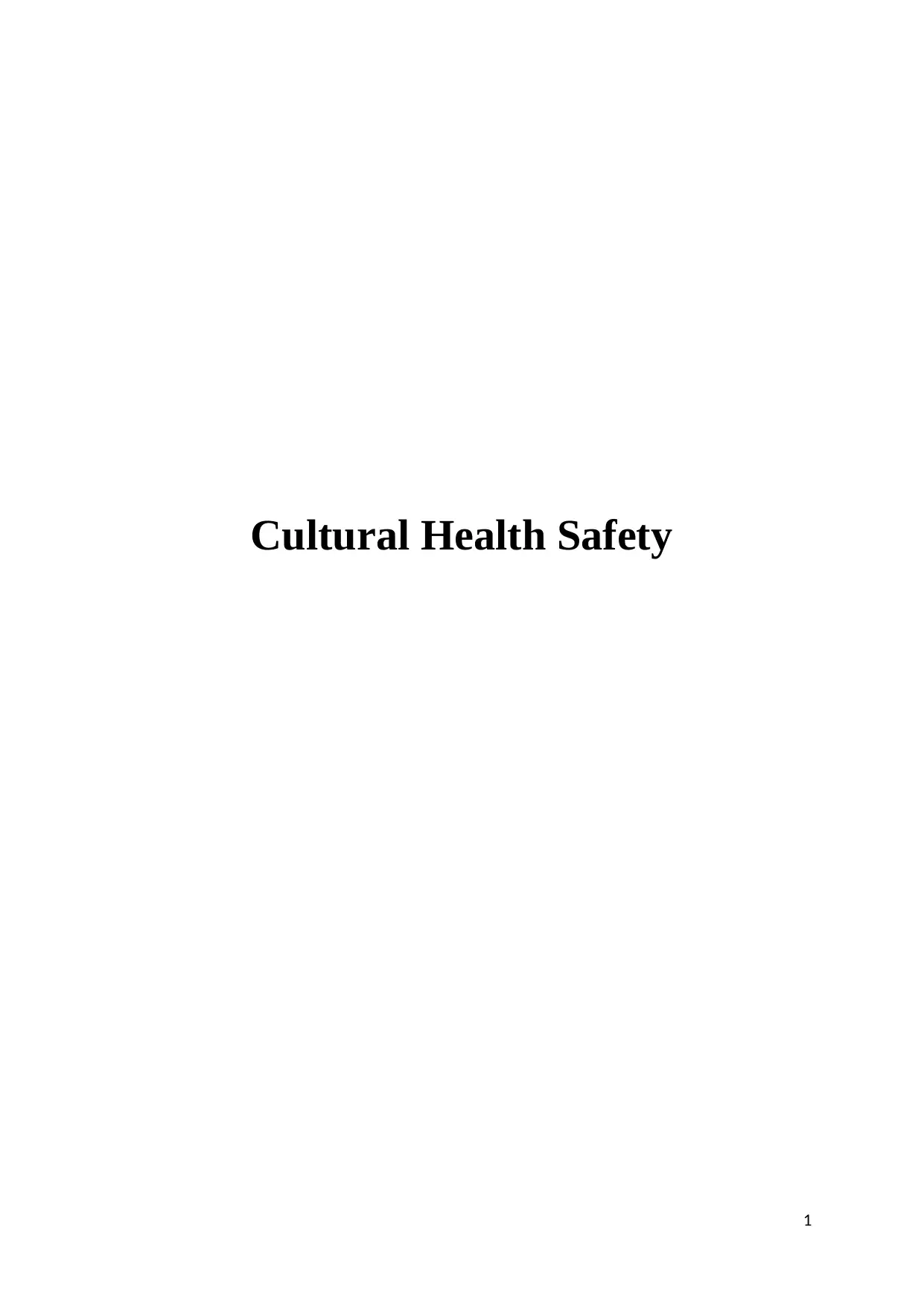
Cultural Health Safety
1
1
Paraphrase This Document
Need a fresh take? Get an instant paraphrase of this document with our AI Paraphraser
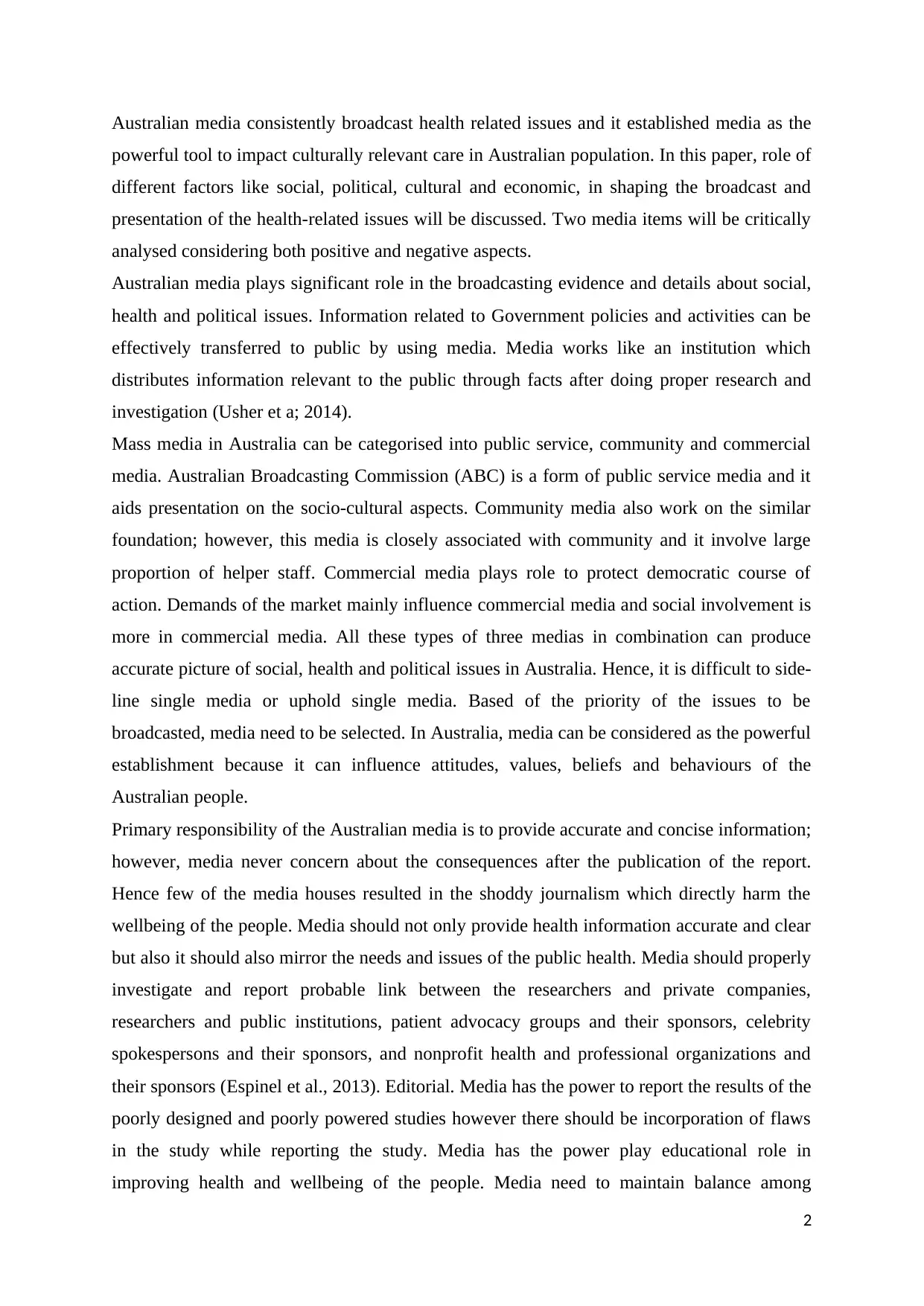
Australian media consistently broadcast health related issues and it established media as the
powerful tool to impact culturally relevant care in Australian population. In this paper, role of
different factors like social, political, cultural and economic, in shaping the broadcast and
presentation of the health-related issues will be discussed. Two media items will be critically
analysed considering both positive and negative aspects.
Australian media plays significant role in the broadcasting evidence and details about social,
health and political issues. Information related to Government policies and activities can be
effectively transferred to public by using media. Media works like an institution which
distributes information relevant to the public through facts after doing proper research and
investigation (Usher et a; 2014).
Mass media in Australia can be categorised into public service, community and commercial
media. Australian Broadcasting Commission (ABC) is a form of public service media and it
aids presentation on the socio-cultural aspects. Community media also work on the similar
foundation; however, this media is closely associated with community and it involve large
proportion of helper staff. Commercial media plays role to protect democratic course of
action. Demands of the market mainly influence commercial media and social involvement is
more in commercial media. All these types of three medias in combination can produce
accurate picture of social, health and political issues in Australia. Hence, it is difficult to side-
line single media or uphold single media. Based of the priority of the issues to be
broadcasted, media need to be selected. In Australia, media can be considered as the powerful
establishment because it can influence attitudes, values, beliefs and behaviours of the
Australian people.
Primary responsibility of the Australian media is to provide accurate and concise information;
however, media never concern about the consequences after the publication of the report.
Hence few of the media houses resulted in the shoddy journalism which directly harm the
wellbeing of the people. Media should not only provide health information accurate and clear
but also it should also mirror the needs and issues of the public health. Media should properly
investigate and report probable link between the researchers and private companies,
researchers and public institutions, patient advocacy groups and their sponsors, celebrity
spokespersons and their sponsors, and nonprofit health and professional organizations and
their sponsors (Espinel et al., 2013). Editorial. Media has the power to report the results of the
poorly designed and poorly powered studies however there should be incorporation of flaws
in the study while reporting the study. Media has the power play educational role in
improving health and wellbeing of the people. Media need to maintain balance among
2
powerful tool to impact culturally relevant care in Australian population. In this paper, role of
different factors like social, political, cultural and economic, in shaping the broadcast and
presentation of the health-related issues will be discussed. Two media items will be critically
analysed considering both positive and negative aspects.
Australian media plays significant role in the broadcasting evidence and details about social,
health and political issues. Information related to Government policies and activities can be
effectively transferred to public by using media. Media works like an institution which
distributes information relevant to the public through facts after doing proper research and
investigation (Usher et a; 2014).
Mass media in Australia can be categorised into public service, community and commercial
media. Australian Broadcasting Commission (ABC) is a form of public service media and it
aids presentation on the socio-cultural aspects. Community media also work on the similar
foundation; however, this media is closely associated with community and it involve large
proportion of helper staff. Commercial media plays role to protect democratic course of
action. Demands of the market mainly influence commercial media and social involvement is
more in commercial media. All these types of three medias in combination can produce
accurate picture of social, health and political issues in Australia. Hence, it is difficult to side-
line single media or uphold single media. Based of the priority of the issues to be
broadcasted, media need to be selected. In Australia, media can be considered as the powerful
establishment because it can influence attitudes, values, beliefs and behaviours of the
Australian people.
Primary responsibility of the Australian media is to provide accurate and concise information;
however, media never concern about the consequences after the publication of the report.
Hence few of the media houses resulted in the shoddy journalism which directly harm the
wellbeing of the people. Media should not only provide health information accurate and clear
but also it should also mirror the needs and issues of the public health. Media should properly
investigate and report probable link between the researchers and private companies,
researchers and public institutions, patient advocacy groups and their sponsors, celebrity
spokespersons and their sponsors, and nonprofit health and professional organizations and
their sponsors (Espinel et al., 2013). Editorial. Media has the power to report the results of the
poorly designed and poorly powered studies however there should be incorporation of flaws
in the study while reporting the study. Media has the power play educational role in
improving health and wellbeing of the people. Media need to maintain balance among
2
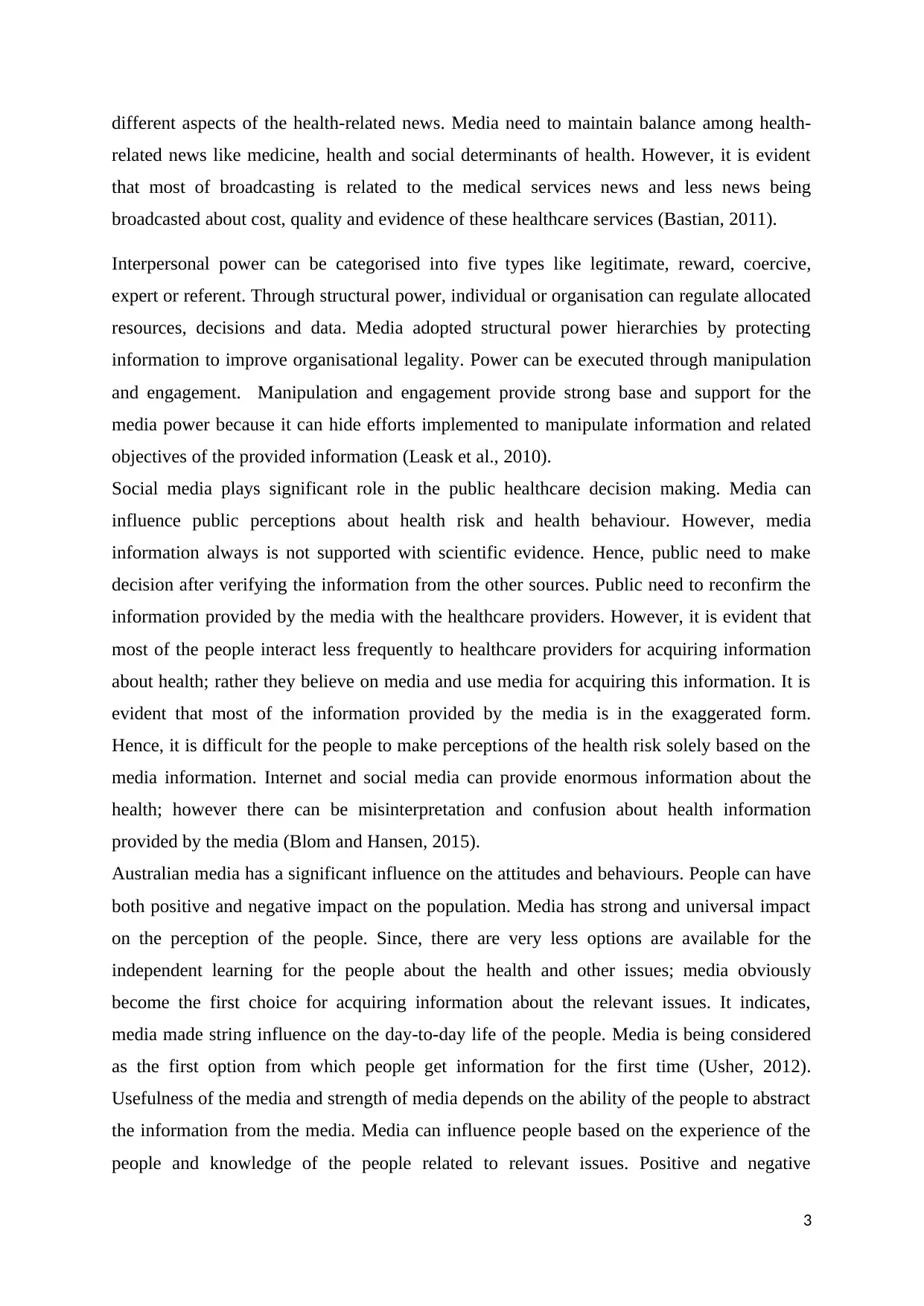
different aspects of the health-related news. Media need to maintain balance among health-
related news like medicine, health and social determinants of health. However, it is evident
that most of broadcasting is related to the medical services news and less news being
broadcasted about cost, quality and evidence of these healthcare services (Bastian, 2011).
Interpersonal power can be categorised into five types like legitimate, reward, coercive,
expert or referent. Through structural power, individual or organisation can regulate allocated
resources, decisions and data. Media adopted structural power hierarchies by protecting
information to improve organisational legality. Power can be executed through manipulation
and engagement. Manipulation and engagement provide strong base and support for the
media power because it can hide efforts implemented to manipulate information and related
objectives of the provided information (Leask et al., 2010).
Social media plays significant role in the public healthcare decision making. Media can
influence public perceptions about health risk and health behaviour. However, media
information always is not supported with scientific evidence. Hence, public need to make
decision after verifying the information from the other sources. Public need to reconfirm the
information provided by the media with the healthcare providers. However, it is evident that
most of the people interact less frequently to healthcare providers for acquiring information
about health; rather they believe on media and use media for acquiring this information. It is
evident that most of the information provided by the media is in the exaggerated form.
Hence, it is difficult for the people to make perceptions of the health risk solely based on the
media information. Internet and social media can provide enormous information about the
health; however there can be misinterpretation and confusion about health information
provided by the media (Blom and Hansen, 2015).
Australian media has a significant influence on the attitudes and behaviours. People can have
both positive and negative impact on the population. Media has strong and universal impact
on the perception of the people. Since, there are very less options are available for the
independent learning for the people about the health and other issues; media obviously
become the first choice for acquiring information about the relevant issues. It indicates,
media made string influence on the day-to-day life of the people. Media is being considered
as the first option from which people get information for the first time (Usher, 2012).
Usefulness of the media and strength of media depends on the ability of the people to abstract
the information from the media. Media can influence people based on the experience of the
people and knowledge of the people related to relevant issues. Positive and negative
3
related news like medicine, health and social determinants of health. However, it is evident
that most of broadcasting is related to the medical services news and less news being
broadcasted about cost, quality and evidence of these healthcare services (Bastian, 2011).
Interpersonal power can be categorised into five types like legitimate, reward, coercive,
expert or referent. Through structural power, individual or organisation can regulate allocated
resources, decisions and data. Media adopted structural power hierarchies by protecting
information to improve organisational legality. Power can be executed through manipulation
and engagement. Manipulation and engagement provide strong base and support for the
media power because it can hide efforts implemented to manipulate information and related
objectives of the provided information (Leask et al., 2010).
Social media plays significant role in the public healthcare decision making. Media can
influence public perceptions about health risk and health behaviour. However, media
information always is not supported with scientific evidence. Hence, public need to make
decision after verifying the information from the other sources. Public need to reconfirm the
information provided by the media with the healthcare providers. However, it is evident that
most of the people interact less frequently to healthcare providers for acquiring information
about health; rather they believe on media and use media for acquiring this information. It is
evident that most of the information provided by the media is in the exaggerated form.
Hence, it is difficult for the people to make perceptions of the health risk solely based on the
media information. Internet and social media can provide enormous information about the
health; however there can be misinterpretation and confusion about health information
provided by the media (Blom and Hansen, 2015).
Australian media has a significant influence on the attitudes and behaviours. People can have
both positive and negative impact on the population. Media has strong and universal impact
on the perception of the people. Since, there are very less options are available for the
independent learning for the people about the health and other issues; media obviously
become the first choice for acquiring information about the relevant issues. It indicates,
media made string influence on the day-to-day life of the people. Media is being considered
as the first option from which people get information for the first time (Usher, 2012).
Usefulness of the media and strength of media depends on the ability of the people to abstract
the information from the media. Media can influence people based on the experience of the
people and knowledge of the people related to relevant issues. Positive and negative
3
⊘ This is a preview!⊘
Do you want full access?
Subscribe today to unlock all pages.

Trusted by 1+ million students worldwide
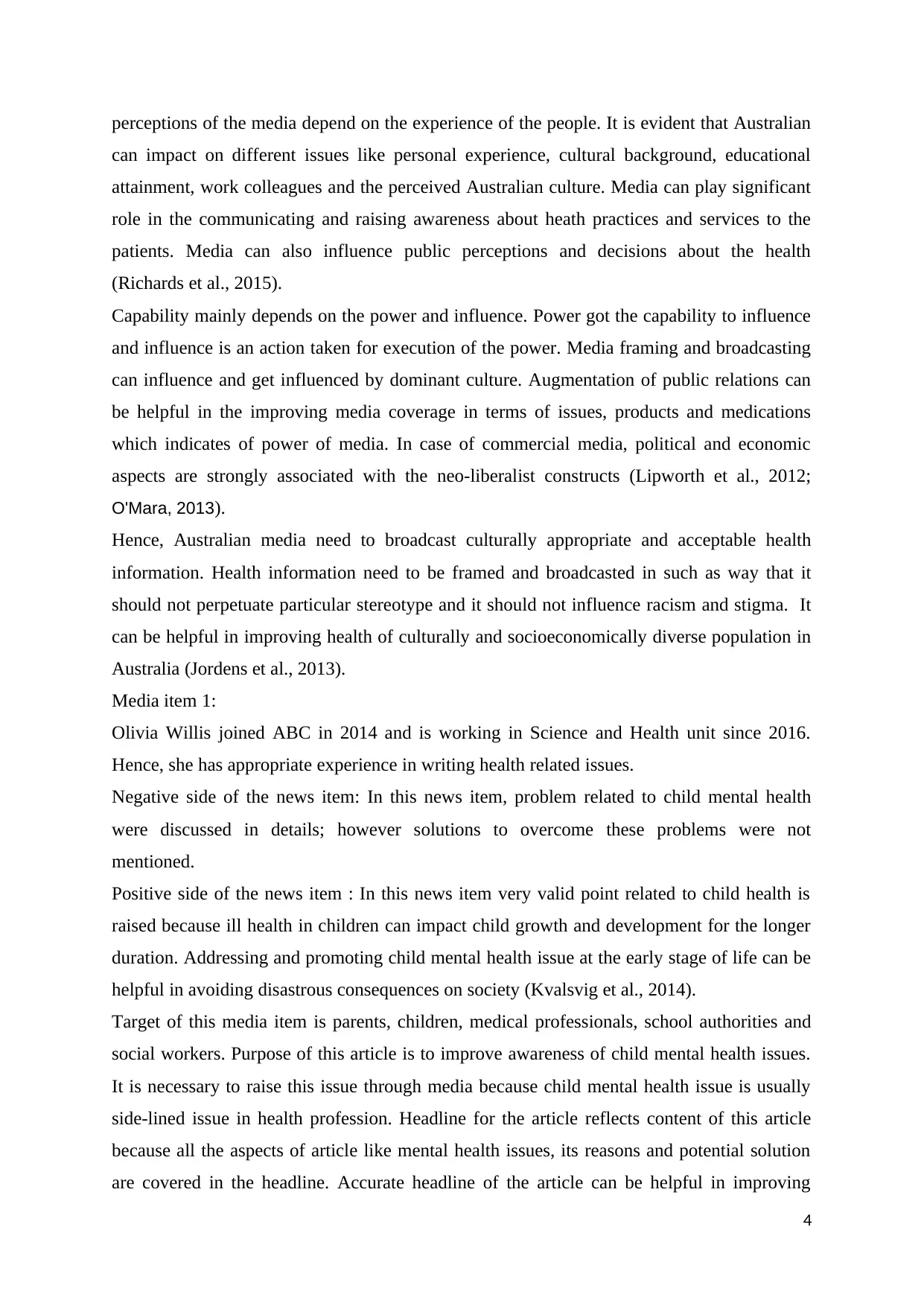
perceptions of the media depend on the experience of the people. It is evident that Australian
can impact on different issues like personal experience, cultural background, educational
attainment, work colleagues and the perceived Australian culture. Media can play significant
role in the communicating and raising awareness about heath practices and services to the
patients. Media can also influence public perceptions and decisions about the health
(Richards et al., 2015).
Capability mainly depends on the power and influence. Power got the capability to influence
and influence is an action taken for execution of the power. Media framing and broadcasting
can influence and get influenced by dominant culture. Augmentation of public relations can
be helpful in the improving media coverage in terms of issues, products and medications
which indicates of power of media. In case of commercial media, political and economic
aspects are strongly associated with the neo-liberalist constructs (Lipworth et al., 2012;
O'Mara, 2013).
Hence, Australian media need to broadcast culturally appropriate and acceptable health
information. Health information need to be framed and broadcasted in such as way that it
should not perpetuate particular stereotype and it should not influence racism and stigma. It
can be helpful in improving health of culturally and socioeconomically diverse population in
Australia (Jordens et al., 2013).
Media item 1:
Olivia Willis joined ABC in 2014 and is working in Science and Health unit since 2016.
Hence, she has appropriate experience in writing health related issues.
Negative side of the news item: In this news item, problem related to child mental health
were discussed in details; however solutions to overcome these problems were not
mentioned.
Positive side of the news item : In this news item very valid point related to child health is
raised because ill health in children can impact child growth and development for the longer
duration. Addressing and promoting child mental health issue at the early stage of life can be
helpful in avoiding disastrous consequences on society (Kvalsvig et al., 2014).
Target of this media item is parents, children, medical professionals, school authorities and
social workers. Purpose of this article is to improve awareness of child mental health issues.
It is necessary to raise this issue through media because child mental health issue is usually
side-lined issue in health profession. Headline for the article reflects content of this article
because all the aspects of article like mental health issues, its reasons and potential solution
are covered in the headline. Accurate headline of the article can be helpful in improving
4
can impact on different issues like personal experience, cultural background, educational
attainment, work colleagues and the perceived Australian culture. Media can play significant
role in the communicating and raising awareness about heath practices and services to the
patients. Media can also influence public perceptions and decisions about the health
(Richards et al., 2015).
Capability mainly depends on the power and influence. Power got the capability to influence
and influence is an action taken for execution of the power. Media framing and broadcasting
can influence and get influenced by dominant culture. Augmentation of public relations can
be helpful in the improving media coverage in terms of issues, products and medications
which indicates of power of media. In case of commercial media, political and economic
aspects are strongly associated with the neo-liberalist constructs (Lipworth et al., 2012;
O'Mara, 2013).
Hence, Australian media need to broadcast culturally appropriate and acceptable health
information. Health information need to be framed and broadcasted in such as way that it
should not perpetuate particular stereotype and it should not influence racism and stigma. It
can be helpful in improving health of culturally and socioeconomically diverse population in
Australia (Jordens et al., 2013).
Media item 1:
Olivia Willis joined ABC in 2014 and is working in Science and Health unit since 2016.
Hence, she has appropriate experience in writing health related issues.
Negative side of the news item: In this news item, problem related to child mental health
were discussed in details; however solutions to overcome these problems were not
mentioned.
Positive side of the news item : In this news item very valid point related to child health is
raised because ill health in children can impact child growth and development for the longer
duration. Addressing and promoting child mental health issue at the early stage of life can be
helpful in avoiding disastrous consequences on society (Kvalsvig et al., 2014).
Target of this media item is parents, children, medical professionals, school authorities and
social workers. Purpose of this article is to improve awareness of child mental health issues.
It is necessary to raise this issue through media because child mental health issue is usually
side-lined issue in health profession. Headline for the article reflects content of this article
because all the aspects of article like mental health issues, its reasons and potential solution
are covered in the headline. Accurate headline of the article can be helpful in improving
4
Paraphrase This Document
Need a fresh take? Get an instant paraphrase of this document with our AI Paraphraser
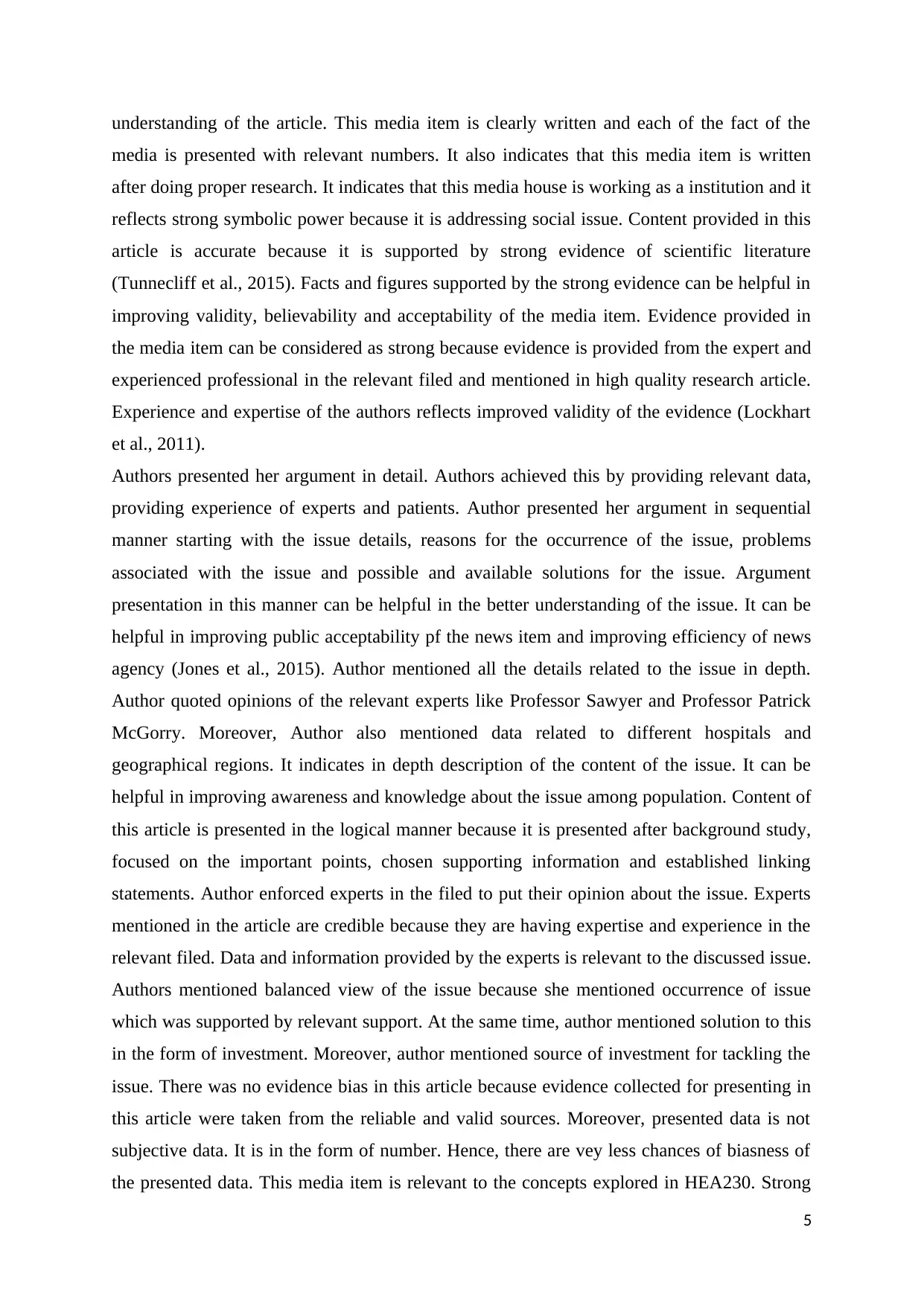
understanding of the article. This media item is clearly written and each of the fact of the
media is presented with relevant numbers. It also indicates that this media item is written
after doing proper research. It indicates that this media house is working as a institution and it
reflects strong symbolic power because it is addressing social issue. Content provided in this
article is accurate because it is supported by strong evidence of scientific literature
(Tunnecliff et al., 2015). Facts and figures supported by the strong evidence can be helpful in
improving validity, believability and acceptability of the media item. Evidence provided in
the media item can be considered as strong because evidence is provided from the expert and
experienced professional in the relevant filed and mentioned in high quality research article.
Experience and expertise of the authors reflects improved validity of the evidence (Lockhart
et al., 2011).
Authors presented her argument in detail. Authors achieved this by providing relevant data,
providing experience of experts and patients. Author presented her argument in sequential
manner starting with the issue details, reasons for the occurrence of the issue, problems
associated with the issue and possible and available solutions for the issue. Argument
presentation in this manner can be helpful in the better understanding of the issue. It can be
helpful in improving public acceptability pf the news item and improving efficiency of news
agency (Jones et al., 2015). Author mentioned all the details related to the issue in depth.
Author quoted opinions of the relevant experts like Professor Sawyer and Professor Patrick
McGorry. Moreover, Author also mentioned data related to different hospitals and
geographical regions. It indicates in depth description of the content of the issue. It can be
helpful in improving awareness and knowledge about the issue among population. Content of
this article is presented in the logical manner because it is presented after background study,
focused on the important points, chosen supporting information and established linking
statements. Author enforced experts in the filed to put their opinion about the issue. Experts
mentioned in the article are credible because they are having expertise and experience in the
relevant filed. Data and information provided by the experts is relevant to the discussed issue.
Authors mentioned balanced view of the issue because she mentioned occurrence of issue
which was supported by relevant support. At the same time, author mentioned solution to this
in the form of investment. Moreover, author mentioned source of investment for tackling the
issue. There was no evidence bias in this article because evidence collected for presenting in
this article were taken from the reliable and valid sources. Moreover, presented data is not
subjective data. It is in the form of number. Hence, there are vey less chances of biasness of
the presented data. This media item is relevant to the concepts explored in HEA230. Strong
5
media is presented with relevant numbers. It also indicates that this media item is written
after doing proper research. It indicates that this media house is working as a institution and it
reflects strong symbolic power because it is addressing social issue. Content provided in this
article is accurate because it is supported by strong evidence of scientific literature
(Tunnecliff et al., 2015). Facts and figures supported by the strong evidence can be helpful in
improving validity, believability and acceptability of the media item. Evidence provided in
the media item can be considered as strong because evidence is provided from the expert and
experienced professional in the relevant filed and mentioned in high quality research article.
Experience and expertise of the authors reflects improved validity of the evidence (Lockhart
et al., 2011).
Authors presented her argument in detail. Authors achieved this by providing relevant data,
providing experience of experts and patients. Author presented her argument in sequential
manner starting with the issue details, reasons for the occurrence of the issue, problems
associated with the issue and possible and available solutions for the issue. Argument
presentation in this manner can be helpful in the better understanding of the issue. It can be
helpful in improving public acceptability pf the news item and improving efficiency of news
agency (Jones et al., 2015). Author mentioned all the details related to the issue in depth.
Author quoted opinions of the relevant experts like Professor Sawyer and Professor Patrick
McGorry. Moreover, Author also mentioned data related to different hospitals and
geographical regions. It indicates in depth description of the content of the issue. It can be
helpful in improving awareness and knowledge about the issue among population. Content of
this article is presented in the logical manner because it is presented after background study,
focused on the important points, chosen supporting information and established linking
statements. Author enforced experts in the filed to put their opinion about the issue. Experts
mentioned in the article are credible because they are having expertise and experience in the
relevant filed. Data and information provided by the experts is relevant to the discussed issue.
Authors mentioned balanced view of the issue because she mentioned occurrence of issue
which was supported by relevant support. At the same time, author mentioned solution to this
in the form of investment. Moreover, author mentioned source of investment for tackling the
issue. There was no evidence bias in this article because evidence collected for presenting in
this article were taken from the reliable and valid sources. Moreover, presented data is not
subjective data. It is in the form of number. Hence, there are vey less chances of biasness of
the presented data. This media item is relevant to the concepts explored in HEA230. Strong
5
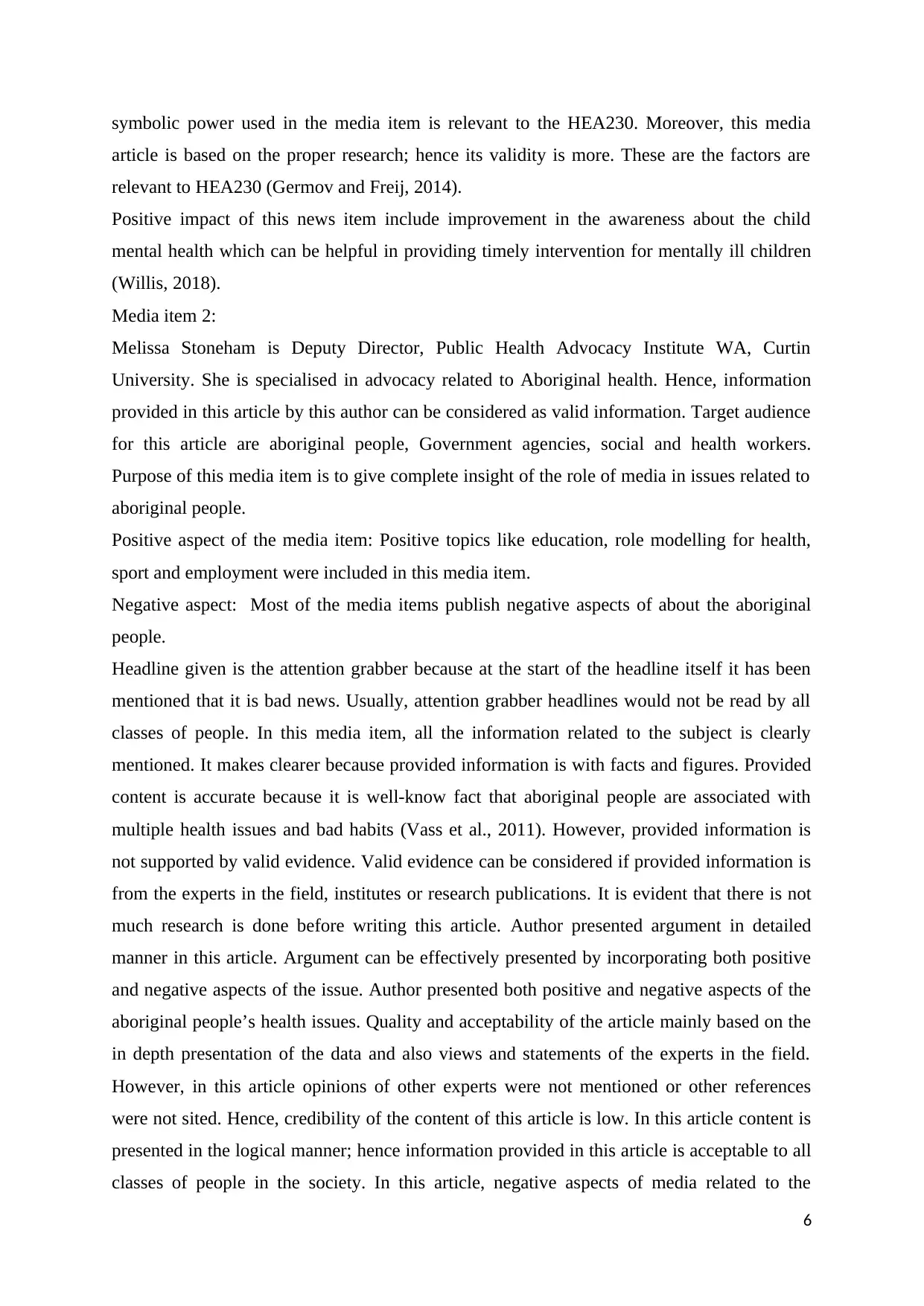
symbolic power used in the media item is relevant to the HEA230. Moreover, this media
article is based on the proper research; hence its validity is more. These are the factors are
relevant to HEA230 (Germov and Freij, 2014).
Positive impact of this news item include improvement in the awareness about the child
mental health which can be helpful in providing timely intervention for mentally ill children
(Willis, 2018).
Media item 2:
Melissa Stoneham is Deputy Director, Public Health Advocacy Institute WA, Curtin
University. She is specialised in advocacy related to Aboriginal health. Hence, information
provided in this article by this author can be considered as valid information. Target audience
for this article are aboriginal people, Government agencies, social and health workers.
Purpose of this media item is to give complete insight of the role of media in issues related to
aboriginal people.
Positive aspect of the media item: Positive topics like education, role modelling for health,
sport and employment were included in this media item.
Negative aspect: Most of the media items publish negative aspects of about the aboriginal
people.
Headline given is the attention grabber because at the start of the headline itself it has been
mentioned that it is bad news. Usually, attention grabber headlines would not be read by all
classes of people. In this media item, all the information related to the subject is clearly
mentioned. It makes clearer because provided information is with facts and figures. Provided
content is accurate because it is well-know fact that aboriginal people are associated with
multiple health issues and bad habits (Vass et al., 2011). However, provided information is
not supported by valid evidence. Valid evidence can be considered if provided information is
from the experts in the field, institutes or research publications. It is evident that there is not
much research is done before writing this article. Author presented argument in detailed
manner in this article. Argument can be effectively presented by incorporating both positive
and negative aspects of the issue. Author presented both positive and negative aspects of the
aboriginal people’s health issues. Quality and acceptability of the article mainly based on the
in depth presentation of the data and also views and statements of the experts in the field.
However, in this article opinions of other experts were not mentioned or other references
were not sited. Hence, credibility of the content of this article is low. In this article content is
presented in the logical manner; hence information provided in this article is acceptable to all
classes of people in the society. In this article, negative aspects of media related to the
6
article is based on the proper research; hence its validity is more. These are the factors are
relevant to HEA230 (Germov and Freij, 2014).
Positive impact of this news item include improvement in the awareness about the child
mental health which can be helpful in providing timely intervention for mentally ill children
(Willis, 2018).
Media item 2:
Melissa Stoneham is Deputy Director, Public Health Advocacy Institute WA, Curtin
University. She is specialised in advocacy related to Aboriginal health. Hence, information
provided in this article by this author can be considered as valid information. Target audience
for this article are aboriginal people, Government agencies, social and health workers.
Purpose of this media item is to give complete insight of the role of media in issues related to
aboriginal people.
Positive aspect of the media item: Positive topics like education, role modelling for health,
sport and employment were included in this media item.
Negative aspect: Most of the media items publish negative aspects of about the aboriginal
people.
Headline given is the attention grabber because at the start of the headline itself it has been
mentioned that it is bad news. Usually, attention grabber headlines would not be read by all
classes of people. In this media item, all the information related to the subject is clearly
mentioned. It makes clearer because provided information is with facts and figures. Provided
content is accurate because it is well-know fact that aboriginal people are associated with
multiple health issues and bad habits (Vass et al., 2011). However, provided information is
not supported by valid evidence. Valid evidence can be considered if provided information is
from the experts in the field, institutes or research publications. It is evident that there is not
much research is done before writing this article. Author presented argument in detailed
manner in this article. Argument can be effectively presented by incorporating both positive
and negative aspects of the issue. Author presented both positive and negative aspects of the
aboriginal people’s health issues. Quality and acceptability of the article mainly based on the
in depth presentation of the data and also views and statements of the experts in the field.
However, in this article opinions of other experts were not mentioned or other references
were not sited. Hence, credibility of the content of this article is low. In this article content is
presented in the logical manner; hence information provided in this article is acceptable to all
classes of people in the society. In this article, negative aspects of media related to the
6
⊘ This is a preview!⊘
Do you want full access?
Subscribe today to unlock all pages.

Trusted by 1+ million students worldwide
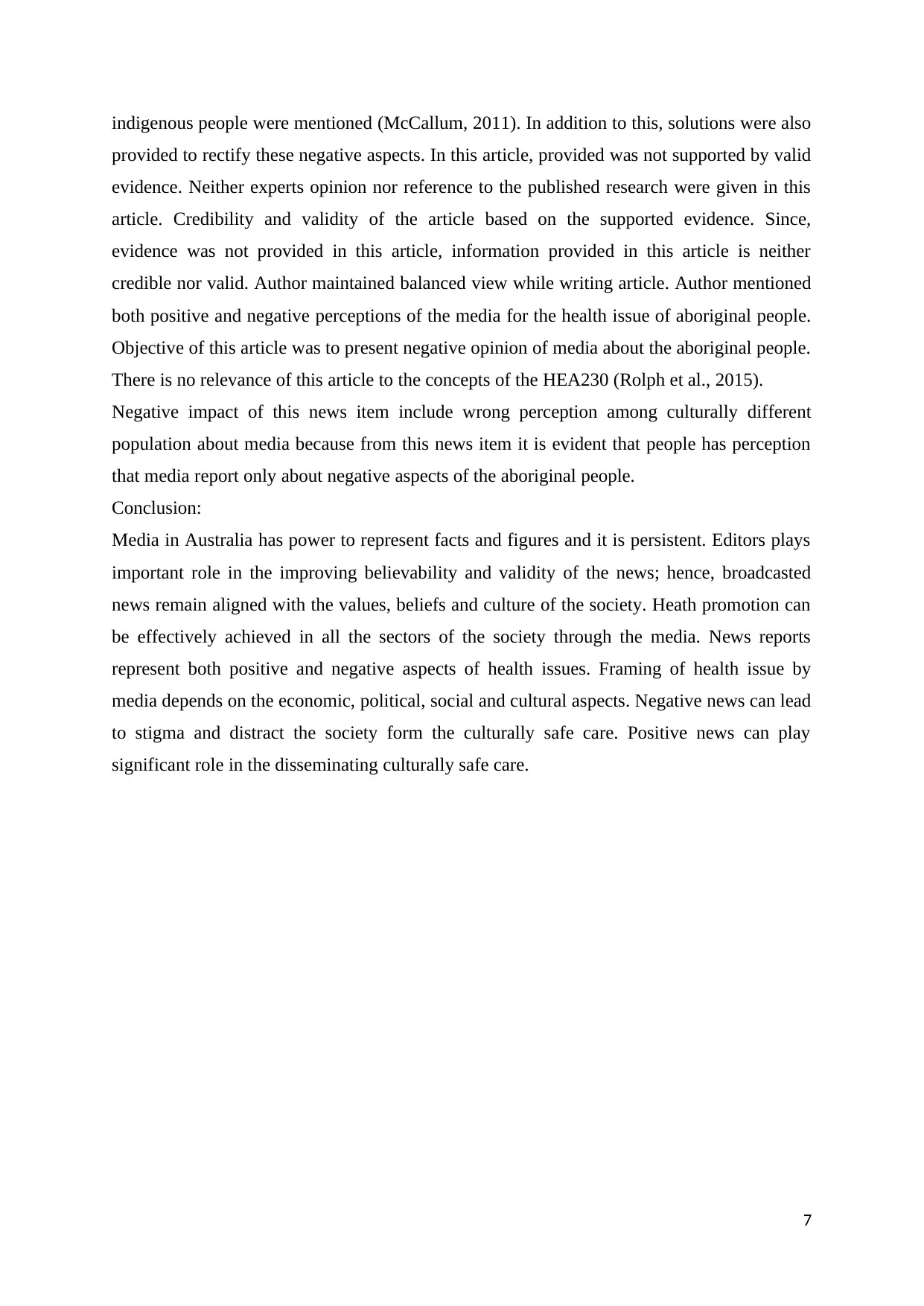
indigenous people were mentioned (McCallum, 2011). In addition to this, solutions were also
provided to rectify these negative aspects. In this article, provided was not supported by valid
evidence. Neither experts opinion nor reference to the published research were given in this
article. Credibility and validity of the article based on the supported evidence. Since,
evidence was not provided in this article, information provided in this article is neither
credible nor valid. Author maintained balanced view while writing article. Author mentioned
both positive and negative perceptions of the media for the health issue of aboriginal people.
Objective of this article was to present negative opinion of media about the aboriginal people.
There is no relevance of this article to the concepts of the HEA230 (Rolph et al., 2015).
Negative impact of this news item include wrong perception among culturally different
population about media because from this news item it is evident that people has perception
that media report only about negative aspects of the aboriginal people.
Conclusion:
Media in Australia has power to represent facts and figures and it is persistent. Editors plays
important role in the improving believability and validity of the news; hence, broadcasted
news remain aligned with the values, beliefs and culture of the society. Heath promotion can
be effectively achieved in all the sectors of the society through the media. News reports
represent both positive and negative aspects of health issues. Framing of health issue by
media depends on the economic, political, social and cultural aspects. Negative news can lead
to stigma and distract the society form the culturally safe care. Positive news can play
significant role in the disseminating culturally safe care.
7
provided to rectify these negative aspects. In this article, provided was not supported by valid
evidence. Neither experts opinion nor reference to the published research were given in this
article. Credibility and validity of the article based on the supported evidence. Since,
evidence was not provided in this article, information provided in this article is neither
credible nor valid. Author maintained balanced view while writing article. Author mentioned
both positive and negative perceptions of the media for the health issue of aboriginal people.
Objective of this article was to present negative opinion of media about the aboriginal people.
There is no relevance of this article to the concepts of the HEA230 (Rolph et al., 2015).
Negative impact of this news item include wrong perception among culturally different
population about media because from this news item it is evident that people has perception
that media report only about negative aspects of the aboriginal people.
Conclusion:
Media in Australia has power to represent facts and figures and it is persistent. Editors plays
important role in the improving believability and validity of the news; hence, broadcasted
news remain aligned with the values, beliefs and culture of the society. Heath promotion can
be effectively achieved in all the sectors of the society through the media. News reports
represent both positive and negative aspects of health issues. Framing of health issue by
media depends on the economic, political, social and cultural aspects. Negative news can lead
to stigma and distract the society form the culturally safe care. Positive news can play
significant role in the disseminating culturally safe care.
7
Paraphrase This Document
Need a fresh take? Get an instant paraphrase of this document with our AI Paraphraser
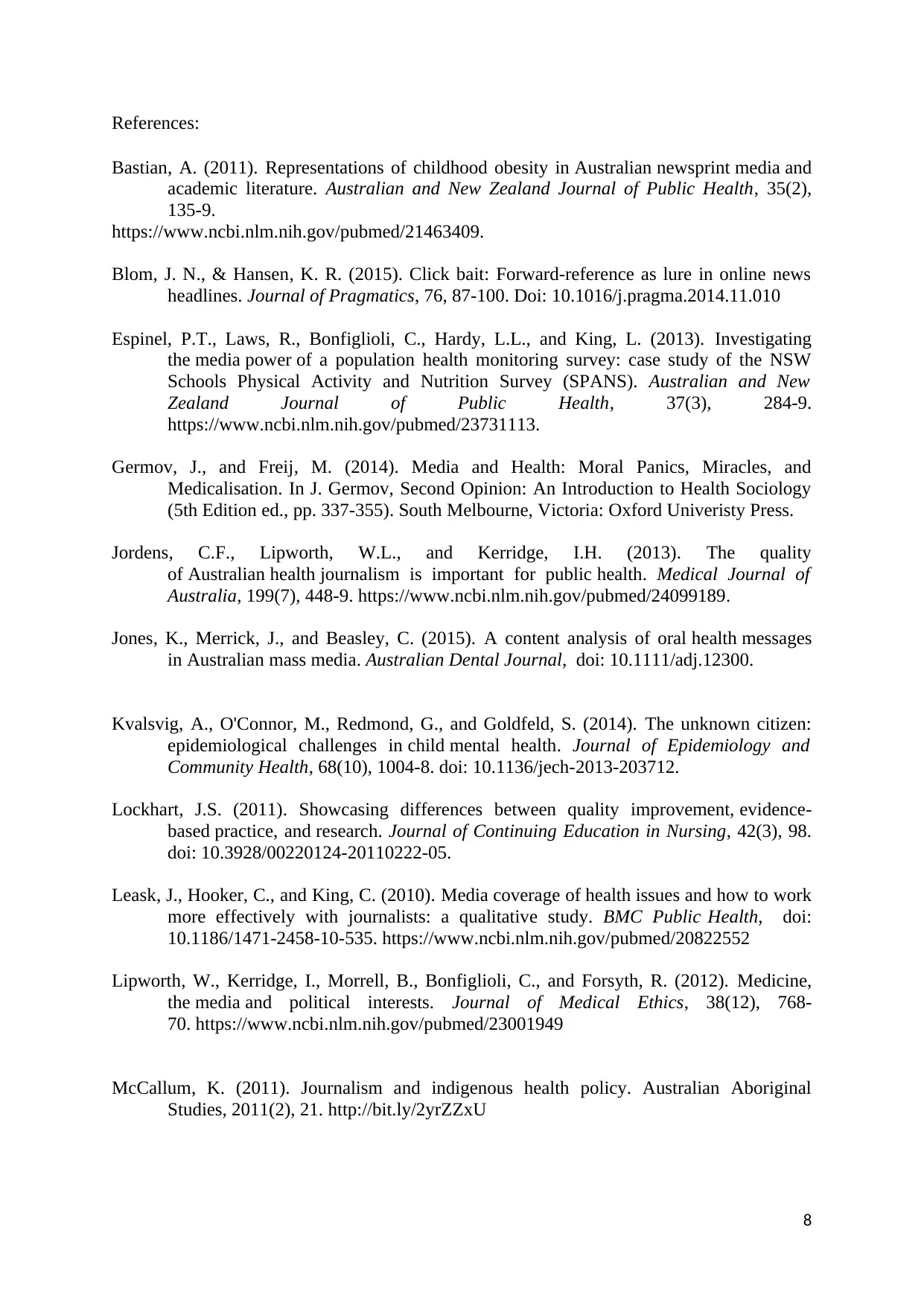
References:
Bastian, A. (2011). Representations of childhood obesity in Australian newsprint media and
academic literature. Australian and New Zealand Journal of Public Health, 35(2),
135-9.
https://www.ncbi.nlm.nih.gov/pubmed/21463409.
Blom, J. N., & Hansen, K. R. (2015). Click bait: Forward-reference as lure in online news
headlines. Journal of Pragmatics, 76, 87-100. Doi: 10.1016/j.pragma.2014.11.010
Espinel, P.T., Laws, R., Bonfiglioli, C., Hardy, L.L., and King, L. (2013). Investigating
the media power of a population health monitoring survey: case study of the NSW
Schools Physical Activity and Nutrition Survey (SPANS). Australian and New
Zealand Journal of Public Health, 37(3), 284-9.
https://www.ncbi.nlm.nih.gov/pubmed/23731113.
Germov, J., and Freij, M. (2014). Media and Health: Moral Panics, Miracles, and
Medicalisation. In J. Germov, Second Opinion: An Introduction to Health Sociology
(5th Edition ed., pp. 337-355). South Melbourne, Victoria: Oxford Univeristy Press.
Jordens, C.F., Lipworth, W.L., and Kerridge, I.H. (2013). The quality
of Australian health journalism is important for public health. Medical Journal of
Australia, 199(7), 448-9. https://www.ncbi.nlm.nih.gov/pubmed/24099189.
Jones, K., Merrick, J., and Beasley, C. (2015). A content analysis of oral health messages
in Australian mass media. Australian Dental Journal, doi: 10.1111/adj.12300.
Kvalsvig, A., O'Connor, M., Redmond, G., and Goldfeld, S. (2014). The unknown citizen:
epidemiological challenges in child mental health. Journal of Epidemiology and
Community Health, 68(10), 1004-8. doi: 10.1136/jech-2013-203712.
Lockhart, J.S. (2011). Showcasing differences between quality improvement, evidence-
based practice, and research. Journal of Continuing Education in Nursing, 42(3), 98.
doi: 10.3928/00220124-20110222-05.
Leask, J., Hooker, C., and King, C. (2010). Media coverage of health issues and how to work
more effectively with journalists: a qualitative study. BMC Public Health, doi:
10.1186/1471-2458-10-535. https://www.ncbi.nlm.nih.gov/pubmed/20822552
Lipworth, W., Kerridge, I., Morrell, B., Bonfiglioli, C., and Forsyth, R. (2012). Medicine,
the media and political interests. Journal of Medical Ethics, 38(12), 768-
70. https://www.ncbi.nlm.nih.gov/pubmed/23001949
McCallum, K. (2011). Journalism and indigenous health policy. Australian Aboriginal
Studies, 2011(2), 21. http://bit.ly/2yrZZxU
8
Bastian, A. (2011). Representations of childhood obesity in Australian newsprint media and
academic literature. Australian and New Zealand Journal of Public Health, 35(2),
135-9.
https://www.ncbi.nlm.nih.gov/pubmed/21463409.
Blom, J. N., & Hansen, K. R. (2015). Click bait: Forward-reference as lure in online news
headlines. Journal of Pragmatics, 76, 87-100. Doi: 10.1016/j.pragma.2014.11.010
Espinel, P.T., Laws, R., Bonfiglioli, C., Hardy, L.L., and King, L. (2013). Investigating
the media power of a population health monitoring survey: case study of the NSW
Schools Physical Activity and Nutrition Survey (SPANS). Australian and New
Zealand Journal of Public Health, 37(3), 284-9.
https://www.ncbi.nlm.nih.gov/pubmed/23731113.
Germov, J., and Freij, M. (2014). Media and Health: Moral Panics, Miracles, and
Medicalisation. In J. Germov, Second Opinion: An Introduction to Health Sociology
(5th Edition ed., pp. 337-355). South Melbourne, Victoria: Oxford Univeristy Press.
Jordens, C.F., Lipworth, W.L., and Kerridge, I.H. (2013). The quality
of Australian health journalism is important for public health. Medical Journal of
Australia, 199(7), 448-9. https://www.ncbi.nlm.nih.gov/pubmed/24099189.
Jones, K., Merrick, J., and Beasley, C. (2015). A content analysis of oral health messages
in Australian mass media. Australian Dental Journal, doi: 10.1111/adj.12300.
Kvalsvig, A., O'Connor, M., Redmond, G., and Goldfeld, S. (2014). The unknown citizen:
epidemiological challenges in child mental health. Journal of Epidemiology and
Community Health, 68(10), 1004-8. doi: 10.1136/jech-2013-203712.
Lockhart, J.S. (2011). Showcasing differences between quality improvement, evidence-
based practice, and research. Journal of Continuing Education in Nursing, 42(3), 98.
doi: 10.3928/00220124-20110222-05.
Leask, J., Hooker, C., and King, C. (2010). Media coverage of health issues and how to work
more effectively with journalists: a qualitative study. BMC Public Health, doi:
10.1186/1471-2458-10-535. https://www.ncbi.nlm.nih.gov/pubmed/20822552
Lipworth, W., Kerridge, I., Morrell, B., Bonfiglioli, C., and Forsyth, R. (2012). Medicine,
the media and political interests. Journal of Medical Ethics, 38(12), 768-
70. https://www.ncbi.nlm.nih.gov/pubmed/23001949
McCallum, K. (2011). Journalism and indigenous health policy. Australian Aboriginal
Studies, 2011(2), 21. http://bit.ly/2yrZZxU
8
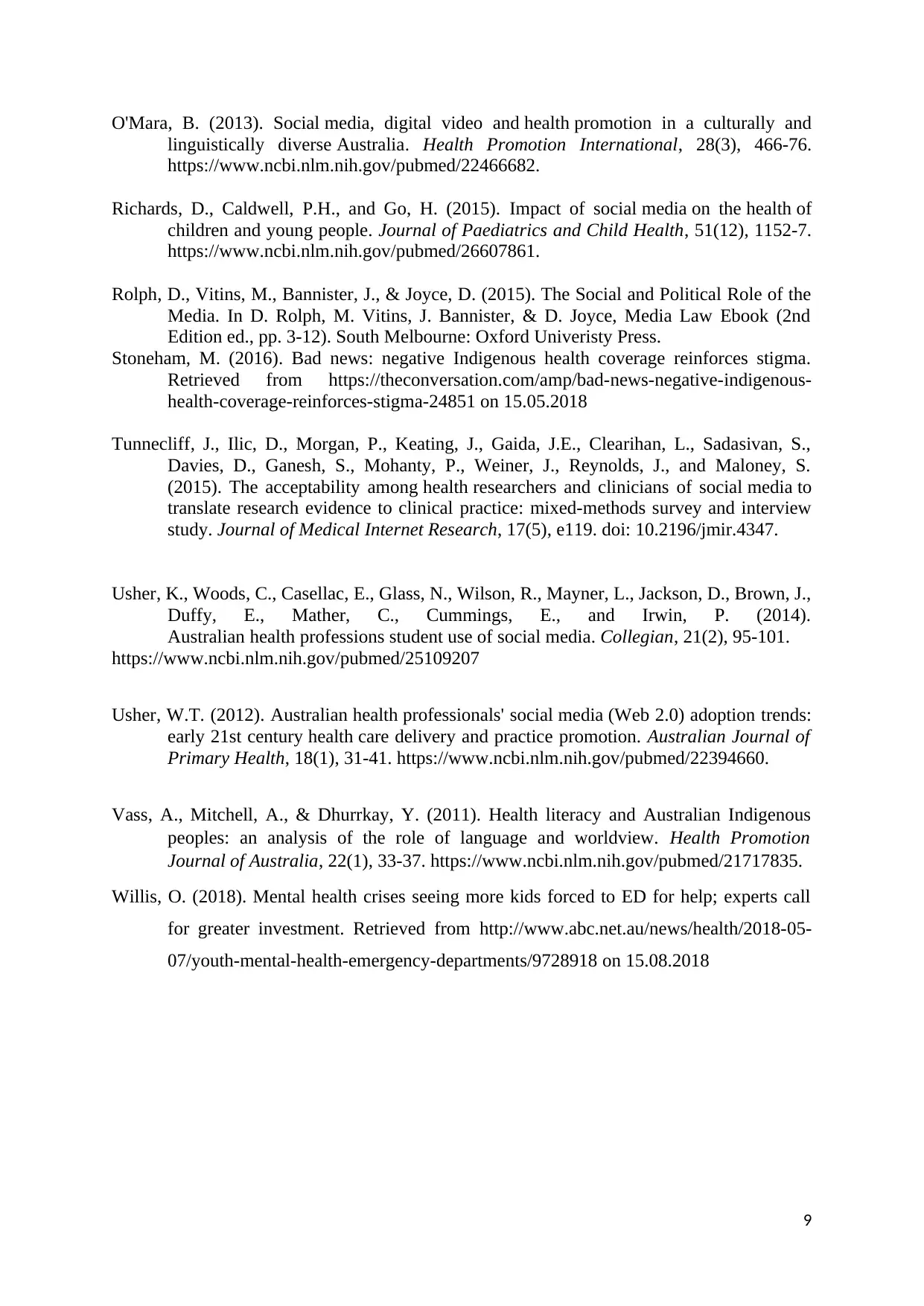
O'Mara, B. (2013). Social media, digital video and health promotion in a culturally and
linguistically diverse Australia. Health Promotion International, 28(3), 466-76.
https://www.ncbi.nlm.nih.gov/pubmed/22466682.
Richards, D., Caldwell, P.H., and Go, H. (2015). Impact of social media on the health of
children and young people. Journal of Paediatrics and Child Health, 51(12), 1152-7.
https://www.ncbi.nlm.nih.gov/pubmed/26607861.
Rolph, D., Vitins, M., Bannister, J., & Joyce, D. (2015). The Social and Political Role of the
Media. In D. Rolph, M. Vitins, J. Bannister, & D. Joyce, Media Law Ebook (2nd
Edition ed., pp. 3-12). South Melbourne: Oxford Univeristy Press.
Stoneham, M. (2016). Bad news: negative Indigenous health coverage reinforces stigma.
Retrieved from https://theconversation.com/amp/bad-news-negative-indigenous-
health-coverage-reinforces-stigma-24851 on 15.05.2018
Tunnecliff, J., Ilic, D., Morgan, P., Keating, J., Gaida, J.E., Clearihan, L., Sadasivan, S.,
Davies, D., Ganesh, S., Mohanty, P., Weiner, J., Reynolds, J., and Maloney, S.
(2015). The acceptability among health researchers and clinicians of social media to
translate research evidence to clinical practice: mixed-methods survey and interview
study. Journal of Medical Internet Research, 17(5), e119. doi: 10.2196/jmir.4347.
Usher, K., Woods, C., Casellac, E., Glass, N., Wilson, R., Mayner, L., Jackson, D., Brown, J.,
Duffy, E., Mather, C., Cummings, E., and Irwin, P. (2014).
Australian health professions student use of social media. Collegian, 21(2), 95-101.
https://www.ncbi.nlm.nih.gov/pubmed/25109207
Usher, W.T. (2012). Australian health professionals' social media (Web 2.0) adoption trends:
early 21st century health care delivery and practice promotion. Australian Journal of
Primary Health, 18(1), 31-41. https://www.ncbi.nlm.nih.gov/pubmed/22394660.
Vass, A., Mitchell, A., & Dhurrkay, Y. (2011). Health literacy and Australian Indigenous
peoples: an analysis of the role of language and worldview. Health Promotion
Journal of Australia, 22(1), 33-37. https://www.ncbi.nlm.nih.gov/pubmed/21717835.
Willis, O. (2018). Mental health crises seeing more kids forced to ED for help; experts call
for greater investment. Retrieved from http://www.abc.net.au/news/health/2018-05-
07/youth-mental-health-emergency-departments/9728918 on 15.08.2018
9
linguistically diverse Australia. Health Promotion International, 28(3), 466-76.
https://www.ncbi.nlm.nih.gov/pubmed/22466682.
Richards, D., Caldwell, P.H., and Go, H. (2015). Impact of social media on the health of
children and young people. Journal of Paediatrics and Child Health, 51(12), 1152-7.
https://www.ncbi.nlm.nih.gov/pubmed/26607861.
Rolph, D., Vitins, M., Bannister, J., & Joyce, D. (2015). The Social and Political Role of the
Media. In D. Rolph, M. Vitins, J. Bannister, & D. Joyce, Media Law Ebook (2nd
Edition ed., pp. 3-12). South Melbourne: Oxford Univeristy Press.
Stoneham, M. (2016). Bad news: negative Indigenous health coverage reinforces stigma.
Retrieved from https://theconversation.com/amp/bad-news-negative-indigenous-
health-coverage-reinforces-stigma-24851 on 15.05.2018
Tunnecliff, J., Ilic, D., Morgan, P., Keating, J., Gaida, J.E., Clearihan, L., Sadasivan, S.,
Davies, D., Ganesh, S., Mohanty, P., Weiner, J., Reynolds, J., and Maloney, S.
(2015). The acceptability among health researchers and clinicians of social media to
translate research evidence to clinical practice: mixed-methods survey and interview
study. Journal of Medical Internet Research, 17(5), e119. doi: 10.2196/jmir.4347.
Usher, K., Woods, C., Casellac, E., Glass, N., Wilson, R., Mayner, L., Jackson, D., Brown, J.,
Duffy, E., Mather, C., Cummings, E., and Irwin, P. (2014).
Australian health professions student use of social media. Collegian, 21(2), 95-101.
https://www.ncbi.nlm.nih.gov/pubmed/25109207
Usher, W.T. (2012). Australian health professionals' social media (Web 2.0) adoption trends:
early 21st century health care delivery and practice promotion. Australian Journal of
Primary Health, 18(1), 31-41. https://www.ncbi.nlm.nih.gov/pubmed/22394660.
Vass, A., Mitchell, A., & Dhurrkay, Y. (2011). Health literacy and Australian Indigenous
peoples: an analysis of the role of language and worldview. Health Promotion
Journal of Australia, 22(1), 33-37. https://www.ncbi.nlm.nih.gov/pubmed/21717835.
Willis, O. (2018). Mental health crises seeing more kids forced to ED for help; experts call
for greater investment. Retrieved from http://www.abc.net.au/news/health/2018-05-
07/youth-mental-health-emergency-departments/9728918 on 15.08.2018
9
⊘ This is a preview!⊘
Do you want full access?
Subscribe today to unlock all pages.

Trusted by 1+ million students worldwide
1 out of 9
Related Documents
Your All-in-One AI-Powered Toolkit for Academic Success.
+13062052269
info@desklib.com
Available 24*7 on WhatsApp / Email
![[object Object]](/_next/static/media/star-bottom.7253800d.svg)
Unlock your academic potential
Copyright © 2020–2025 A2Z Services. All Rights Reserved. Developed and managed by ZUCOL.





